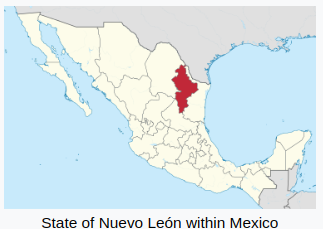
Credit Wikipedia
#17,094
Two weeks ago Mexico announced their first detection of HPAI H5 - in a wild gyrfalcon - and began urging their poultry industry to take immediate actions to protect their flocks (see SENASICA report Agriculture reports case of avian influenza AH5N1 in wild birds).
Mexico is no stranger to dealing with avian flu, albeit primarily HPAI H7 (see PLoS One: Rapid Evolution of Mexican H7N3 HPAI Viruses In Poultry).
Senasica detects circulation of avian influenza H5N1 in Montemorelos, Nuevo León
The presence of avian influenza H5N1 does not represent any risk for the consumption of chicken and eggs.
National Service for Agrifood Health, Safety and Quality | October 30, 2022
Senasica confirmed the circulation of the Highly Pathogenic Avian Influenza virus (HPAI) AH5N1 in a commercial laying farm in Montemorelos, Nuevo León, with a population of 60,000 birds.
The finding is the product of the timely notification of a producer from Nuevo León, in accordance with the epidemiological surveillance actions carried out by the Ministry of Agriculture and Rural Development, to protect the country's chicken and egg production, within the framework of the National Device of Emergency (Dinesa), activated last June.
The finding is the product of the timely notification of a producer from Nuevo León, in accordance with the epidemiological surveillance actions carried out by the Ministry of Agriculture and Rural Development, to protect the country's chicken and egg production, within the framework of the National Device of Emergency (Dinesa), activated last June.
Immediately, technicians from the United States-Mexico Commission for the Prevention of Foot-and-Mouth Disease and Other Exotic Animal Diseases (CPA) of the Senasica went to take the corresponding samples and the presence of the virus was confirmed in the official laboratories, for which took the corresponding anti-epidemic measures.The technicians installed the corresponding quarantine and the indicated sanitary measures were applied, so the depopulation, cleaning and disinfection, sanitary vacuum and sentinelization of the farm will be carried out.The Agriculture agency emphasized that the presence of HPAI AH5N1 does not represent any risk for the consumption of chicken and eggs.Likewise, the Senasica reported that a new case was found in wild birds in Tijuana, Baja California, and in a family laying farm in the municipality of Juárez, Chiapas, with a population of 186 birds.He said that migrations from Canada and the United States are causing outbreaks of HPAI AH5N1 in wild birds in various parts of the country, for which he reiterated his urge to commercial and family poultry producers to strictly comply with biosecurity measures and avoid at all costs. the entry of birds into their poultry production units.With the purpose of contributing to protect the production of chicken meat and eggs, the Senasica invited producers, veterinarians and the general population to immediately notify any suspicion they detect, for which it puts at their disposal the telephone number 800 751 2100 and the Avise app, on iOS and Android systems.
They can also report at any office of the Secretary of Agriculture, Senasica or Coordination of the CPA, located in all states of the country.Consult more information at: Senasica detects circulation of the HPAI H5N1 virus in a farm in Montemorelos, Nuevo León
A month ago, in FAO Update: Global Avian Influenza Viruses with Zoonotic Potential, we looked at the unprecedented spread of avian flu over the 2021-2022 season.
Over the past 2 years HPAI H5Nx has expanded both its host range (see DEFRA: The Unprecedented `Order Shift' In Wild Bird H5N1 Positives In Europe & The UK) and its territory.
New records continue to be set in Europe (see UK DEFRA: Avian Influenza: Prevention Zone Declared Across Great Britain), and the occasional spillover of the virus into mammals (see here, here, here and here) only increases its threat.
While HPAI H5Nx remains primarily a threat to wild birds and poultry, it continues to evolve in unpredictable ways (see Spain: Avian H5N1 Spillover Into Farmed Mink), making it a threat very much worthy of our attention.